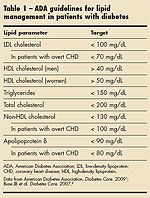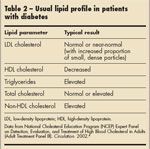- Clinical Technology
- Adult Immunization
- Hepatology
- Pediatric Immunization
- Screening
- Psychiatry
- Allergy
- Women's Health
- Cardiology
- Pediatrics
- Dermatology
- Endocrinology
- Pain Management
- Gastroenterology
- Infectious Disease
- Obesity Medicine
- Rheumatology
- Nephrology
- Neurology
- Pulmonology
Lipids: Key to Cardiovascular Health in Patients With Diabetes
Evidence-based medicine supports the aggressive management ofdyslipidemia to prevent cardiovascular disease (CVD) in patients withtype 2 diabetes
Q: What is the optimal medical approach to managing dyslipidemia in type 2 diabetes?
A: Evidence-based medicine supports the aggressive management of dyslipidemia to prevent cardiovascular disease (CVD) in patients with type 2 diabetes (Table 1).1-3 The usual pattern of lipid abnormalities seen in those who have type 2 diabetes is the combination of:
- Elevated triglyceride levels.
- Low high-density lipoprotein (HDL) cholesterol levels.
- Normal or elevated low-density lipoprotein (LDL) cholesterol levels.
Also, in patients with diabetes, the LDL cholesterol often contains an increased proportion of small, dense LDL particles (compared with the proportion in patients who do not have diabetes) (Table 2); these small, dense LDL particles are important in the pathogenesis of atherosclerosis.1,4,5

The United Kingdom Prospective Diabetes Study researchers6 found that the rank order of risk factors for the development of coronary artery disease in patients with diabetes was as follows:
- Elevated LDL cholesterol levels.
- Decreased HDL cholesterol levels.
- Elevated hemoglobin A1C.
- Elevated systolic blood pressure.
- Smoking.
Thus, although glycemic control is essential to reducing the development and progression of coronary artery disease in patients with type 2 diabetes, lipid management actually plays a larger role in the prevention of CVD, which is the greatest cause of mortality in these patients. Nonetheless, only 40% of patients with diagnosed coronary heart disease and diabetes have LDL cholesterol levels lower than 100 mg/dL.7,8

LDL CHOLESTEROL
The recommended target for LDL cholesterol is less than 100 mg/dL in patients with diabetes who have typical levels of diabetes-related cardiovascular risk and less than 70 mg/dL in those at greatest risk for heart disease and those with overt cardiac disease. Also, persons with diabetes who have a “near-normal” LDL cholesterol level have a much higher risk of heart disease than do persons without diabetes who have similar levels-because of the higher proportion of small, dense LDL particles. These particles are more readily oxidized and glycated, and they invade the arterial wall more easily, which leads to rapid atherosclerosis.2,9
LDL cholesterol is the primary target of lipid-lowering therapy, and statins are the recommended agents for achieving LDL cholesterol treatment goals.10 In patients with diabetes, start with a mid-range dosage for the specific agent chosen and then increase the dosage sequentially to achieve target goals. For those patients who either are in the high-risk group or have overt cardiac disease, use a dosage in the maximum range. Although all statins are effective in patients with type 2 diabetes, atorvastatin has been shown to be efficacious for both primary and secondary prevention of cardiovascular events.11 Other agents that are useful for lowering LDL cholesterol levels include ezetimibe and bile acid sequestrants.

HDL CHOLESTEROL
The target for HDL cholesterol in patients with diabetes is at least 40 mg/dL for men and 50 mg/dL for women. HDL cholesterol is often low in persons with type 2 diabetes. Three interventions can increase HDL cholesterol levels:
- Consumption of red wine.
- Intense aerobic exercise.
- Drug therapy.
The most potent agent is nicotinic acid, which raises HDL cholesterol levels by 15% to 35%.12 Other agents that raise HDL cholesterol levels include statins (causing increases of 5% to 15%) and fibric acid derivatives (causing increases of 10% to 20%).4,13,14
TOTAL CHOLESTEROL
The target for total cholesterol in patients with type 2 diabetes is 200 mg/dL or lower. Total cholesterol levels are improved with statin therapy. In most patients, when efforts are focused on improving the individual components of the lipid profile, the total cholesterol level falls into the acceptable range.
TRIGLYCERIDES
Triglyceride levels in patients with diabetes should be less than 150 mg/dL. In meta-analyses, elevated triglyceride levels have been found to be an independent risk factor for coronary heart disease.15,16 Dietary therapy is an important component of the treatment of elevated triglyceride levels: a reduction of carbohydrates in the diet to less than 60% of caloric intake lowers these levels (Table 3). High alcohol intake also promotes elevated triglyceride levels. Limiting alcohol consumption is recommended as one measure that can lower triglyceride levels. Drugs that can lower triglyceride levels include nicotinic acid (leading to reductions of 20% to 50%), fibric acid derivatives (reductions of 20% to 50%), and statins (reductions of 7% to 30%).4
NON-HDL CHOLESTEROL
Non-HDL cholesterol is calculated by subtracting the HDL cholesterol level from the total cholesterol level.17,18 This value is a reliable, convenient (because it can be obtained when the patient is in a non-fasting state), and inexpensive parameter that is useful for assessing cardiovascular risk in patients with triglyceride levels greater than 200 mg/dL.
The non-HDL cholesterol measure approximates the amount of apolipoprotein B (the most important apolipoprotein of all atherogenic lipoproteins) and can thus determine the overall cardiovascular risk in patients with type 2 diabetes. The small triglyceride-laden lipoproteins that contain the apolipoprotein B molecule are a major cause of atherogenesis because of their small size, prolonged time in the plasma, and ability to diffuse easily in the arterial wall and promote foam-cell formation. LDL cholesterol levels do not necessarily reflect the risk of atherosclerosis in patients with diabetes because this routine measurement does not include these small particles. The atherosclerosis risk can be assessed by quantifying the apolipoprotein B level (see Table 1), but this is an expensive test.19 Calculating the non-HDL cholesterol is a cost-effective alternate method.
The treatment goal for non-HDL cholesterol in patients with diabetes is no more than 30 mg/dL higher than the recommended LDL cholesterol level. In patients with diabetes who have typical levels of diabetes-associated cardiovascular risk, this translates to a non-HDL cholesterol level of less than 130 mg/dL, and for those at highest risk for CVD, the non-HDL target is less than 100 mg/dL. As with other lipid parameters, non-HDL cholesterol levels are lowered with statin therapy.
TREATMENT RECOMMENDATIONS
The treatment of lipid disorders in patients with type 2 diabetes often requires a combination approach because of the number of lipid parameters that are typically out-of-range. One can begin with a statin and then add either ezetimibe, a bile acid sequestrant, a fibrate, or nicotinic acid. The choice of a second agent is often determined by adverse effects, the presence of liver or renal disease, and relative cost. Using non-HDL cholesterol levels to follow the progress of high-risk patients is a cost-effective strategy.
References:
REFERENCES:
1. American Diabetes Association. Clinical practice recommendations 2009. Diabetes Care. 2009;32(suppl 1):S29-S31.
2. Goldberg IJ. Clinical review 124. Diabetic dyslipidemia: causes and consequences. J Clin Endocrinol Metab. 2001;86:965-971.
3. Buse JB, Ginsberg HN, Bakris GL, et al. Primary prevention of cardiovascular diseases in people with diabetes mellitus: a scientific statement from the American Heart Association and the American Diabetes Association. Diabetes Care. 2007;30:162-172.
4. National Cholesterol Education Program (NCEP) Expert Panel on Detection, Evaluation, and Treatment of High Blood Cholesterol in Adults (Adult Treatment Panel III). Third report of the National Cholesterol Education Program (NCEP) Expert Panel on Detection, Evaluation, and Treatment of High Blood Cholesterol in Adults (Adult Treatment Panel III) final report. Circulation. 2002;106: 3143-3421.
5. Mooradian AD. Dyslipidemia in type 2 diabetes mellitus. Nat Clin Pract Endocrinol Metab. 2009;5:150-159.
6. Turner RC, Millns H, Neil HA, et al. Risk factors for coronary artery disease in non-insulin dependent diabetes mellitus: United Kingdom Prospective Diabetes Study (UKPDS: 23). BMJ. 1998;316:823-828.
7. Davidson MH, Maki KC, Pearson TA, et al. Results of the National Cholesterol Education (NCEP) Program Evaluation Project Utilizing Novel E-Technology (NEPTUNE) II survey and implications for treatment under the recent NCEP Writing Group recommendations. Am J Cardiol. 2005;96:556-563.
8. Tovar JM, Bazaldua OV, Loffredo A. Diabetic dyslipidemia: a practical guide to therapy. J Fam Pract. 2008;57:377-388.
9. Krentz AJ. Lipoprotein abnormalities and their consequences for patients with type 2 diabetes. Diabetes Obes Metab. 2003;5(supp 1):S19-S27.
10. Nesto RW. LDL cholesterol lowering in type 2 diabetes: what is the optimum approach? Clin Diabetes. 2008;26:8-13.
11. Arca M. Atorvastatin efficacy in the prevention of cardiovascular events in patients with diabetes mellitus and/or metabolic syndrome. Drugs. 2007;67 (suppl 1):43-54.
12. Rader DJ. Pathophysiology and management of low high-density lipoprotein cholesterol. Am J Cardiol. 1999;83(9B):22F-24F.
13. Solano MP, Goldberg RB. Lipid management in type 2 diabetes. Clin Diabetes. 2006;24:27-32.
14.Physicians’ Desk Reference. 63rd ed. Montvale, NJ: Thomson PDR; 2009:403, 482, 521, 2064, 2269, 2503.
15. Austin MA, Hokanson JE, Edwards KL. Hypertriglyceridemia as a cardiovascular risk factor. Am J Cardiol. 1998;81(4A):7B-12B.
16. Assmann G, Schulte H, Funke H, von Eckardstein A. The emergence of triglycerides as a significant independent risk factor in coronary artery disease. Eur Heart J. 1998;19(suppl M):M8-M14.
17. Brunzell JD, Davidson M, Furberg CD, et al. Lipoprotein management in patients with cardiometabolic risk: consensus statement from the American Diabetes Association and the American College of Cardiology Foundation. Diabetes Care. 2008;31:811-822.
18. Shahady EJ. Non-HDL cholesterol: when-and how-to treat.Consultant. 2008;48:745-752.
19.
Peters AL. Clinical relevance of non-HDL cholesterol in patients with diabetes.
Clin Diabetes
. 2008;26:3-7.
